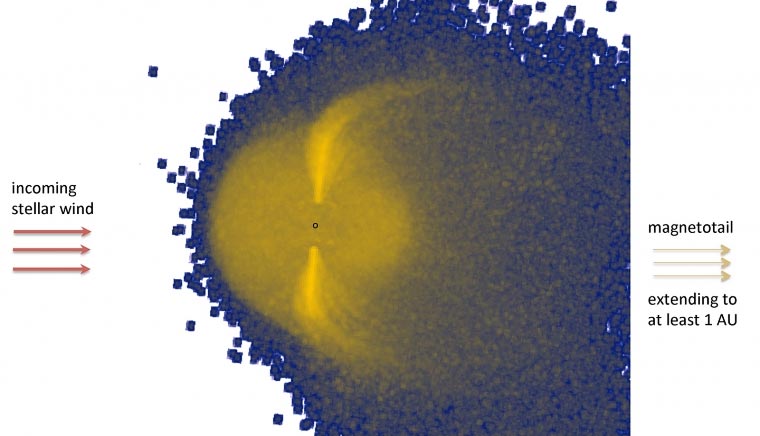Key Takeaways:
- Scientists used Hubble Space Telescope data to identify the first direct evidence of a magnetic field on a planet outside our solar system (exoplanet).
- Magnetic fields shield planetary atmospheres from harmful solar wind particles, potentially impacting a planet’s habitability.
- The discovery focused on exoplanet HAT-P-11b, a Neptune-sized planet with a magnetic field and a magnetosphere (region of charged particles) detected by observing carbon ions.
- While magnetic fields are crucial for habitability, more research is needed to determine the definitive link between magnetic fields and an exoplanet’s ability to support life.
- This exoplanet challenges existing models due to its low metallicity (heavy elements) atmosphere, resembling a mini-Jupiter despite its Neptune-like size.
Using data collected by the Hubble Space Telescope, an international team of scientists was able to identify the obvious evidence of a magnetic field on a planet outside our solar system. The discovery is the first instance of such a feature being observed on an exoplanet and is explained in a report published in the journal Nature Astronomy.
The observations of an extended zone of charged carbon particles surrounding the planet and flowing out from it in a long tail are best explained by a magnetic field. The capacity to identify the magnetic fields of exoplanets is an important step toward better understanding what these alien worlds might look like, since magnetic fields are essential for shielding planetary atmospheres.
The exoplanet HAT-P-11b, a Neptune-sized planet located 123 light-years from Earth, was observed by the researchers using Hubble to observe six “transits” in which it passed straight across the face of its host star. The ultraviolet light spectrum, which is somewhat outside of human vision, is where the observations were made.
Within the planet’s magnetosphere, which is made up of charged particles that react to magnetic fields, Hubble discovered carbon ions. An area surrounding a celestial object, like Earth, that is created by the object’s interaction with the solar wind that its host star emits is known as a magnetosphere.

Gilda Ballester, an adjunct research professor at the University of Arizona Lunar and Planetary Laboratory and one of the paper’s co-authors, stated, “This is the first time the signature of an exoplanet’s magnetic field has been directly detected on a planet outside our solar system.” “A strong magnetic field on a planet like Earth can protect its atmosphere and surface from direct bombardment of the energetic particles that make up the solar wind. These processes heavily affect the evolution of life on a planet like Earth because the magnetic field shelters organisms from these energetic particles.”
The magnetosphere of HAT-P-11b has been found, which is a major step toward a better understanding of an exoplanet’s habitability. The researchers note that not every planet and moon in our solar system has a magnetic field of its own, and that further research is still needed to determine the relationship between magnetic fields and a planet’s habitability.
In addition to saying that this general technique could be used to detect magnetospheres on a variety of exoplanets and to assess their role in potential habitability, Ballester said, “HAT-P-11 b has proven to be a very exciting target, because Hubble’s UV transit observations have revealed a magnetosphere, seen as both an extended ion component around the planet and long tail of escaping ions.”
Ballester played a role in the choice of this particular target for ultraviolet research as a principal investigator of one of the Hubble Space Telescope missions that studied HAT-P-11b. The finding of carbon ions in a lengthy tail that extended away from the planet at average speeds of 100,000 mph, in addition to an area surrounding the planet, was a significant discovery. At least one astronomical unit, or the distance between Earth and the sun, was reached by the tail into space.
The interactions between the planet’s topmost atmospheric regions and magnetic field and the incoming solar wind were then modeled using 3D computer simulations by researchers at the Institute of Astrophysics in Paris, lead by Lotfi Ben-Jaffel, the paper’s first author.
“There are interactions between HAT-P-11b’s magnetic field and its immediate space environment with the solar wind from its host star, and those are very complex, just as Earth’s magnetic field and its immediate space environment interact with the impinging solar wind, which consists of charged particles traveling at about 900,000 mph,” Ballester said.
The exoplanet’s upper atmosphere warms and effectively “boils off” into space as a result of its close proximity to its star—just one-twentieth of Earth’s distance from the sun—but the physics in the magnetospheres of Earth and HAT-P-11b are the same. This leads to the formation of the magnetotail.
The metallicity of HAT-P-11b’s atmosphere, or the quantity of chemical elements in an object heavier than hydrogen and helium, was also discovered by researchers to be lower than predicted. The considerably larger gas planets, Jupiter and Saturn, in our solar system have low metallicity and strong magnetic fields, whereas the icy gas planets, Neptune and Uranus, are rich in metals but have moderate magnetic fields. HAT-P-11b’s low atmospheric metallicity challenges current models of exoplanet formation, the authors say.
“Although HAT-P-11b’s mass is only 8% of that of Jupiter, we think the exoplanet more resembles a mini-Jupiter than a Neptune,” Ballester said. “Our observations of the atmospheric composition on HAT-P-11b indicate that additional research is necessary to improve current theories regarding the formation of certain exoplanets in general.”


